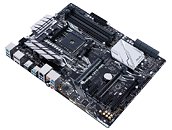Thursday, November 23rd 2017

ASUS BIOS Change-log Reveals New Ryzen Processors Incoming
ASUS recently released BIOS updates for its socket AM4 motherboards based on AMD X370 and B350 chipsets, which implement AGESA 1.0.0.7, which as you'll recall, paves the way for implementing support for upcoming processors, based on AMD's Vega-infused "Raven Ridge" APU silicon, and the 12 nm refreshed Ryzen "Pinnacle Ridge" silicon due for February 2018. ASUS published, and later withdrew the BIOS updates as the media got whiff of them.
The next parts for AMD's mainstream-desktop socket AM4 platform will be Ryzen "Raven Ridge" APUs, which let you finally use the HDMI and DisplayPorts on your motherboards. "Raven Ridge" combines a quad-core "Zen" CPU with a 640-stream processor integrated graphics based on the "Vega" graphics architecture. The "late-2017 or early-2018" time-line for these chips still appears to stand. RedGamingTech suggests that AMD's answer to Intel "Coffee Lake" processors, the 12 nm Ryzen "Pinnacle Ridge" processors, could be out by as early (or late) as February 2018. These chips could be previewed or teased at the company's events held on the sidelines of the 2018 International CES.
Source:
RedGamingTech (YouTube)
The next parts for AMD's mainstream-desktop socket AM4 platform will be Ryzen "Raven Ridge" APUs, which let you finally use the HDMI and DisplayPorts on your motherboards. "Raven Ridge" combines a quad-core "Zen" CPU with a 640-stream processor integrated graphics based on the "Vega" graphics architecture. The "late-2017 or early-2018" time-line for these chips still appears to stand. RedGamingTech suggests that AMD's answer to Intel "Coffee Lake" processors, the 12 nm Ryzen "Pinnacle Ridge" processors, could be out by as early (or late) as February 2018. These chips could be previewed or teased at the company's events held on the sidelines of the 2018 International CES.

21 Comments on ASUS BIOS Change-log Reveals New Ryzen Processors Incoming
Increase ipc... don't make me laugh. Sky>Kaby>Coffee has 0 (ZERO) ipc gain.
Core uArch hit a wall, they can only increase clockspeeds. And that is gonna hit a wall soon as well
Version 32032017/11/17 7.69 MBytes
PRIME X370-PRO BIOS 3203
Update to AGESA 1071 for new upcoming processors .
www.asus.com/Motherboards/PRIME-X370-PRO/HelpDesk_BIOS/Huh? You must not have been on the internet since Ryzen launched then, as they're quite overclockable. Sure, they don't start as high as Intel, nor do they go quite as high, but an 850MHz on all eight cores is ok imho.
Also, Intel might have 8-core mainstream cpu's relatively soon (end this year-beginning next apparently). Maybe I should wait just a little bit longer and I might as well see if a vega refresh or next-gen geforce rolls around. tbh, for purely gaming my a8 6600k/gtx760 pc works just fine with cleverly chosen settings, so I don't NEED to upgrade and I'm busy till the end of the year, so I haven't got much time to game anyway. Gives me some more time to save up money too and who knows what awesome monitors will be available in a few months time? Maybe a high refresh OLED panel, an improved version of the ag352ucg (would be nice considering the aw3418's and z35p's prices) or even a 100Hz+ 3840x1600 monitor?
Maybe being busy isn't a bad thing after all!
It will take Intel all of 2018 just to get yields of coffee lake up, let alone their next gen processors. Intel can't really afford to play core wars with their current design vs AMD. It costs Intel much more to produce it's larger dies than it does AMD with their multi-die design and not to mention the yields of Ryzen are much much better.
I'm hoping Ryzen 12nm will have the full skylake/kabylake Intel IPC at least and 4.3-4.4ghz boost clocks for the x-SKU's. 4.7-4.8ghz oc air would be amazing, and 4.8-4.9 water would be even better! 4.5-4.6 is a likely limit though, but Ryzen was only clocked so low because it's 1st gen of the new architecture and it was designed to be efficiënt, not necessarily fast, so maybe they can get the efficiency from 12nm and just ramp up the speeds quite a bit!
NO
Does it help modularity - Yes.
Is it near the engineering perfection of Ryzen - NO, it's simply multiple dies still thus it's kinda useless for Intel still and to tackle performance uplift while improving modularity is a bit of a handful.
Ryzen was made with modularity in mind, it's the entire strategy of the company and been so for a long long time while they've not been fortunate they finally got a CEO which knows what matters.
Modularity was an asset they had from the phenom days and it's just slightly improved whilst performance was missing.
Intel has performance but needs modularity.
Unless AMD has a crappy deal with glofo they can outprice any Intel part due to their modular design.
What does it mean for end user? - Nothing much really, but AMD can play the price game still and make money
AMD can at least refresh a entire lineup in short time and feed enough parts for each segment cause they only have to make a single part which gives us a stiff competition if Intel is up to the task.
they say ipc and or singlethread when they mean frequency\single core boost freq and so on.. :/
I assume 5% performance in games with an added 2% is ipc and 3% in latency optimization internally and 5-10% performance in clock speed.
Should battle coffe lake reasonably.